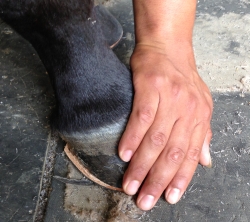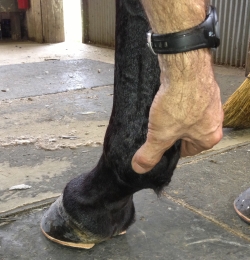When keeping tabs on a horse’s well-being, it is essential to monitor hooves constantly, especially when the horse is not acting quite right.
The quickest and most direct way to examine hooves is to palm the outside of a hoof and check for excessive heat (Fig. 1). Doing this often enough to know what “normal” is for that horse is important when trying to determine if a problem exists. For a problem in one hoof (unilateral), simply comparing the temperatures from right to left is much easier than trying to determine a problem on both sides (bilateral) of either front or back feet. A simultaneous problem in all four feet (quadrilateral) is an indication of a possible systemic problem that should be taken more seriously in terms of veterinary assistance.
Digital pulse rate is another way to check on the soundness of hooves. Palpating the palmar digital arteries for an increased intensity of the pulse there is important. With a little practice, one can easily feel that pulse where those arteries pass over the sesamoid bones (Fig. 2). All vets and farriers know how to find this pulse area.
 (Photos by the author) Fig. 1: "The quickest and most direct way to examine hooves is to palm the outside of a hoof and check for excessive heat."
(Photos by the author) Fig. 1: "The quickest and most direct way to examine hooves is to palm the outside of a hoof and check for excessive heat."
“An increase in the amplitude of the digital pulse merely signifies an increase in the pressure of blood flow to the hoof,” wrote Simon Curtis in Corrective Farriery, A Textbook of Remedial Horseshoeing. “However, it is a highly significant and useful clinical sign as it generally indicates inflammation within the hoof.”
It is important to compare the right and left legs when trying to diagnose a problem.
“Comparison of the strength of pulse in opposite legs may be helpful in diagnosing insidious (rapid-onset) lameness,” wrote Dr. Doug Butler in The Principles of Horseshoeing.
Dr. Butler also notes several factors that increase or decrease pulse rates. Some decreasing factors are cold weather, sleep, old age, dehydration and exhaustion. Some factors that increase pulse rate are fright, excitement, hot weather, exercise, pain and fever. Dr. Butler also noted that 1 degree of fever could increase the pulse rate of a horse by eight beats per minute. According to “The Horse,” normal heart rate for an adult horse at rest is 28-44 beats per minute. “Normal” pulse rate changes with age; older horses trend lower and younger horses trend higher. The fitness of a racehorse is an obvious factor as well. Having said all that, I believe the best indication of hoof health is the intensity of that digital pulse.
 Fig. 2: "With a little practice, one can easily feel that pulse where those arteries pass over the sesamoid bones."
Fig. 2: "With a little practice, one can easily feel that pulse where those arteries pass over the sesamoid bones."
As with any malady, early recognition is an important key to rapid recovery, be it a racehorse, broodmare, foal or yearling. I watched Marcus Johansson use this technique to save a big race for Passionate Glide. Johansson, along with head trainer Jimmy Takter, recognized the problem early, allowing time to fix a minor problem with her back feet. Had they waited just a couple more days until the issue manifested itself more visually, she probably would have missed her race that week which, by the way, she won.
Knowing how to keep better tabs on horses’ hooves can keep horsemen from entering into more advanced stages of hoof ailments. Pulse and temperature are two of the vital signs for a healthy hoof. Learning how to properly monitor these indicators has potential to save a big race on the track, or prevent a trip to the clinic from the farm.
Either way, it just might help stop the rise of your own heart rate.
Veteran Standardbred farrier Steve Stanley of Lexington, Ky., authors a monthly column for Hoof Beats, the official harness racing publication of the U.S. Trotting Association. The American Farriers Journal Editorial Advisory Board member offers plenty of practical advice that will be of special interest regardless of the type of horses that you work with. Click here to read more from Steve Stanley's Hoof Beats series.








Post a comment
Report Abusive Comment